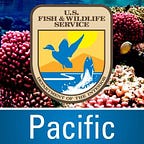How You Can Help Sea Turtles During Nesting Season
The Public Can Help Protect Turtles and Report Nesting Activity
By Jordan Akiyama, Public Affairs Specialist, U.S. Fish and Wildlife Service
The U.S. Fish and Wildlife Service, National Oceanic and Atmospheric Administration, and Hawai‘i Department of Land and Natural Resources Division of Aquatic Resources are asking the public to help honu (green sea turtles) and honu‘ea (hawksbill sea turtles) by keeping a respectful distance from them and their nests.
Honu, honu‘ea and olive ridley sea turtles have all been known to nest on Hawai‘i’s beaches. Recently, an increasing number of honu have been nesting on the main Hawaiian Islands, with 58 nests documented on O‘ahu in 2020. Sea turtle programs state-wide documented almost 100 honu nests, plus an additional 44 honu ‘ea nests. All three sea turtles are protected under the U.S. Federal Endangered Species Act.
While it is not possible to predict the level of nesting activity in Hawai‘i this year, state and federal offices along with state-wide partners are gearing up for the upcoming summer nesting season. The nesting season typically lasts from mid-April through early September.
“The unprecedented level of nesting activity last year took everyone by surprise,” said Dr. Sheldon Plentovich, USFWS coastal program coordinator. “Since 2016 we have worked with community volunteers to locate and monitor sea turtle nests. Between 2016 and 2019 we never observed more than 10 nests on O‘ahu, so finding 58 in 2020 was very exciting for our team and the local community.”
The honu‘ea nests primarily on the islands of Hawaiʹi, Maui, and Moloka‘i, while honu are known to use beaches statewide. In Hawai‘i, sea turtles typically lay their nest at night near or under coastal vegetation well above the high tide line. In contrast, basking turtles are usually found closer to the water both during the day and at night. They like to flip sand with their front flippers when basking, but digging with their rear flippers might be an indicator of nesting activity.
If you see a sea turtle on the beach, in the water, or observe any suspected nesting activity, please remember to:
● View sea turtles from a distance of at least 10 feet. Do not touch, feed, or chase them.
o Harassing or disrupting a sea turtle or their nest can incur significant penalties, including fines of up to $100,000 and imprisonment of up to one year.
● Avoid beach driving off-road vehicles (trucks and ATVs) on beaches that can crush nests, create tire ruts that trap hatchlings, and degrade habitats. Driving on the beach is also illegal in most areas.
o Report illegal beach driving to the Police Department or to DOCARE (643-DLNR).
● Avoid shining bright lights near sea turtles or on nesting beaches after dusk (such as flash photography, cell phone screen lights, vehicle lights, exterior building lights, beach fires, etc.).
o Light pollution can disorient turtles, leading them to wander inland, into vegetation or roads, and away from the ocean.
o If you suspect that you may live near a nesting beach, please contact the USFWS and request information on ‘turtle friendly lighting’.
● Don’t discard fishing line or other rubbish on the beach as sea turtles and their hatchlings can become entangled in them. E no’ono’o pono and help to keep our reefs and beaches clean.
● Report any suspected nesting activities to NOAA by calling 1–888–256–9840 or by emailing RespectWildlife@noaa.gov.
Sea turtle nesting in Hawai‘i provides a unique opportunity for biologists and volunteers to engage with the public to help find and track nesting activity. Members of the public interested in volunteering during this upcoming nesting season to help survey beaches for nesting activity may send an email of interest to RespectWildlife@noaa.gov.
The U.S. Fish and Wildlife Service works with others to conserve, protect, and enhance fish, wildlife, plants, and their habitats for the continuing benefit of the American people. For more information, connect with us through any of these social media channels at https://www.facebook.com/PacificIslandsFWS, www.flickr.com/photos/usfwspacific/, or www.twitter.com/USFWSPacific.
